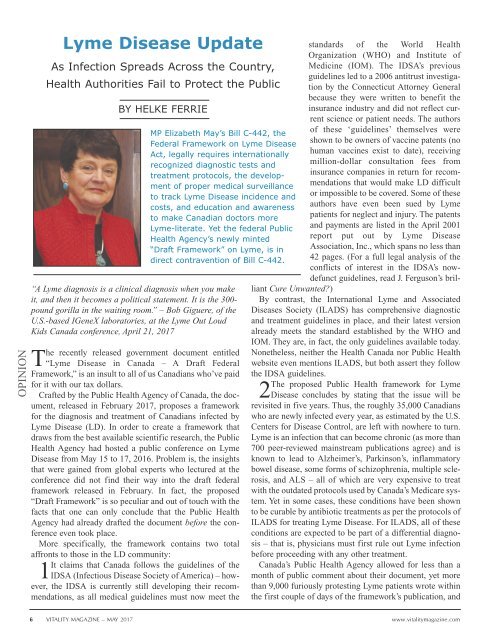Create successful ePaper yourself
Turn your PDF publications into a flip-book with our unique Google optimized e-Paper software.
OPINION<br />
Lyme Disease Update<br />
As Infection Spreads Across the Country,<br />
Health Authorities Fail to Protect the Public<br />
BY HELKE FERRIE<br />
MP Elizabeth <strong>May</strong>’s Bill C-442, the<br />
Federal Framework on Lyme Disease<br />
Act, legally requires internationally<br />
recognized diagnostic tests and<br />
treatment protocols, the development<br />
of proper medical surveillance<br />
to track Lyme Disease incidence and<br />
costs, and education and awareness<br />
to make Canadian doctors more<br />
Lyme-literate. Yet the federal Public<br />
Health Agency’s newly minted<br />
“Draft Framework” on Lyme, is in<br />
direct contravention of Bill C-442.<br />
“A Lyme diagnosis is a clinical diagnosis when you make<br />
it, and then it becomes a political statement. It is the 300-<br />
pound gorilla in the waiting room.” – Bob Giguere, of the<br />
U.S.-based IGeneX laboratories, at the Lyme Out Loud<br />
Kids Canada conference, April 21, <strong>2017</strong><br />
The recently released government document entitled<br />
“Lyme Disease in Canada – A Draft Federal<br />
Framework,” is an insult to all of us Canadians who’ve paid<br />
for it with our tax dollars.<br />
Crafted by the Public Health Agency of Canada, the document,<br />
released in February <strong>2017</strong>, proposes a framework<br />
for the diagnosis and treatment of Canadians infected by<br />
Lyme Disease (LD). In order to create a framework that<br />
draws from the best available scientific research, the Public<br />
Health Agency had hosted a public conference on Lyme<br />
Disease from <strong>May</strong> 15 to 17, 2016. Problem is, the insights<br />
that were gained from global experts who lectured at the<br />
conference did not find their way into the draft federal<br />
framework released in February. In fact, the proposed<br />
“Draft Framework” is so peculiar and out of touch with the<br />
facts that one can only conclude that the Public Health<br />
Agency had already drafted the document before the conference<br />
even took place.<br />
More specifically, the framework contains two total<br />
affronts to those in the LD community:<br />
1It claims that Canada follows the guidelines of the<br />
IDSA (Infectious Disease Society of America) – however,<br />
the IDSA is currently still developing their recommendations,<br />
as all medical guidelines must now meet the<br />
standards of the World Health<br />
Organization (WHO) and Institute of<br />
Medicine (IOM). The IDSA’s previous<br />
guidelines led to a 2006 antitrust investigation<br />
by the Connecticut Attorney General<br />
because they were written to benefit the<br />
insurance industry and did not reflect current<br />
science or patient needs. The authors<br />
of these ‘guidelines’ themselves were<br />
shown to be owners of vaccine patents (no<br />
human vaccines exist to date), receiving<br />
million-dollar consultation fees from<br />
insurance companies in return for recommendations<br />
that would make LD difficult<br />
or impossible to be covered. Some of these<br />
authors have even been sued by Lyme<br />
patients for neglect and injury. The patents<br />
and payments are listed in the April 2001<br />
report put out by Lyme Disease<br />
Association, Inc., which spans no less than<br />
42 pages. (For a full legal analysis of the<br />
conflicts of interest in the IDSA’s nowdefunct<br />
guidelines, read J. Ferguson’s brilliant<br />
Cure Unwanted?)<br />
By contrast, the International Lyme and Associated<br />
Diseases Society (ILADS) has comprehensive diagnostic<br />
and treatment guidelines in place, and their latest version<br />
already meets the standard established by the WHO and<br />
IOM. They are, in fact, the only guidelines available today.<br />
Nonetheless, neither the Health Canada nor Public Health<br />
website even mentions ILADS, but both assert they follow<br />
the IDSA guidelines.<br />
2<br />
The<br />
proposed Public Health framework for Lyme<br />
Disease concludes by stating that the issue will be<br />
revisited in five years. Thus, the roughly 35,000 Canadians<br />
who are newly infected every year, as estimated by the U.S.<br />
Centers for Disease Control, are left with nowhere to turn.<br />
Lyme is an infection that can become chronic (as more than<br />
700 peer-reviewed mainstream publications agree) and is<br />
known to lead to Alzheimer’s, Parkinson’s, inflammatory<br />
bowel disease, some forms of schizophrenia, multiple sclerosis,<br />
and ALS – all of which are very expensive to treat<br />
with the outdated protocols used by Canada’s Medicare system.<br />
Yet in some cases, these conditions have been shown<br />
to be curable by antibiotic treatments as per the protocols of<br />
ILADS for treating Lyme Disease. For ILADS, all of these<br />
conditions are expected to be part of a differential diagnosis<br />
– that is, physicians must first rule out Lyme infection<br />
before proceeding with any other treatment.<br />
Canada’s Public Health Agency allowed for less than a<br />
month of public comment about their document, yet more<br />
than 9,000 furiously protesting Lyme patients wrote within<br />
the first couple of days of the framework’s publication, and<br />
6 VITALITY MAGAZINE – MAY <strong>2017</strong> www.vitalitymagazine.com





